The 2018-19 season didn’t end well for the Boston Bruins.
It’s a shame that this outlook has to be started on such a down-note, especially considering the Bruins were one win away from hoisting the Stanley Cup and solidifying their place atop the hockey world.
Unfortunately, things don’t always go as planned and general manager Don Sweeney and co. now have to regroup quickly and prepare for what’s sure to be a busy offseason with a lot of hard decisions in store.
Included in those decisions will be figuring out which players on expiring contracts they plan on bringing back, which players they plan on giving long-term or bridge-deals to (which could be hampered by what the player themselves are looking for), which players could be traded and up until a week ago, planning for the draft.
For starters, the Bruins will have to make a decision on Marcus Johansson and whether or not they want to, and are feasibly able to re-sign him prior to July 1.
Making a Decision on Marcus Johansson
If the Bruins are going to re-sign Johansson, they’ll want it to be on a short-term contract with a reasonable cap-hit. For Johansson, however, that option can’t seem very enticing as he’s going to be 29 years old by the time the 2019-20 season rolls around and he already has a history of injuries that will likely lead him to wanting long-term security.
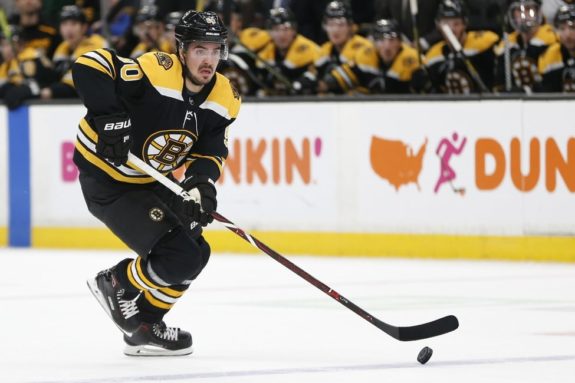
On the surface, it’s easy to want Johansson back in the fold given what he, Charlie Coyle and Danton Heinen were able to do for the Bruins’ third line in the postseason.
In 10 regular season games with the Bruins, Johansson would only score one goal and three points. He’d then produce four goals and 11 points in 22 postseason contests while looking every bit the player the Bruins were acquiring at the deadline. Between his creativity, playmaking ability and chemistry with Coyle, it was hard to not be impressed just about every time Johansson stepped onto the ice.
Unfortunately for the Bruins, retaining Johansson won’t be as easy as giving him a short-term deal worth minimal value.
Comparing Johansson’s Potential Deal to Jordan Eberle’s Extension
If we’re comparing Johansson’s situation to Jordan Eberle signing his new contract with the New York Islanders, it would have made sense to pencil Johansson’s next deal down for an identical $5.5 million per season on a five-year term.
Related: Jordan Eberle Signs Contract Extension With Islanders
During the 2018-19 season, Johansson averaged 0.22 goals-per-game and 0.51 points-per-game to Eberle’s 0.24 goals-per-game and 0.47 points-per-game.
The numbers are fairly similar, and they stay similar when looking at the last five seasons worth of points from each player as well.
Over the last five seasons, Johansson has averaged 0.24 goals-per-game as well as 0.6 points-per-game (79 goals and 195 points in 325 games). Eberle, on the other hand, has averaged 0.28 goals-per-game and 0.65 points-per-game (113 goals and 257 points in 391 games).
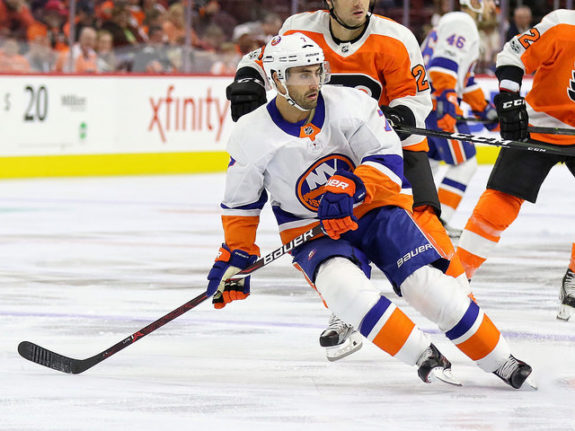
It isn’t always as simple as looking at pure averages, though, as Johansson has also dealt with his fair share of injuries, as mentioned, which should give the Bruins pause about signing him to a long-term deal at such a high cap hit.
Assuming Johansson wants a long-term deal with a good pay-day, the Bruins would be best suited letting him walk despite how talented he proved to be on the team’s third line last season.
Part of the decision to let Johansson walks stems from the fact that the team needs to pay Charlie McAvoy and Brandon Carlo this offseason.
Re-Signing Charlie McAvoy and Brandon Carlo
Right-shot defenders are a premium in the NHL and to think otherwise would be to ignore the obvious. This is why it was so important for the Bruins to hit on both Carlo and McAvoy in the 2015 and 2016 NHL Entry Drafts, respectively.
The cost of winning in the NHL includes supplementing expensive veteran contracts with young, inexpensive role players who can eventually become those expensive veteran players. It’s a cycle that, if done right, never ends.
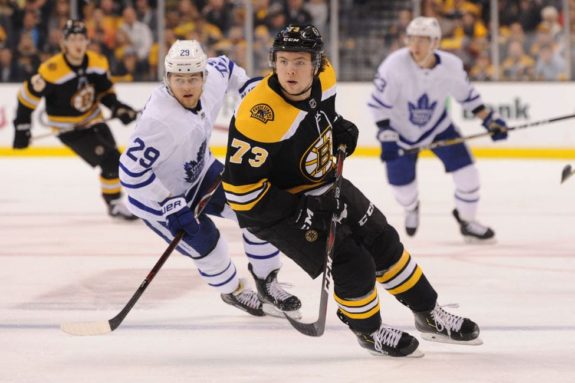
Unfortunately, though, sometimes those young players earn big contract extensions sooner than is realistically feasible and teams have to make tough decisions on who they can and cannot afford to pay.
When it comes to McAvoy and Carlo, though, the Bruins can feasibly afford both and getting them under new deals is the most important task of the 2019 offseason.
With McAvoy, the Bruins are a legitimate cornerstone defender who’s still only 21 years old. He’s proven he can log huge minutes both in the regular season and the postseason, including the Stanley Cup Final this season, and he took a significant step forward as a power play quarterback in the postseason.
It’s easy to ignore McAvoy’s power-play presence with Krug on the roster, but if given a bigger role he could definitely find more tangible success.
Signing him to a seven or eight-year deal worth $7-8 million annually shouldn’t scare the Bruins or fans of the team. If that’s the cost of locking up their No. 1 defender for six-to-eight years who wants to spend his career in Boston, then they have to sign it without hesitation. The cost will only go up if they wait.
His lack of offense may be concerning but it really shouldn’t be given how important he is defensively to the team. The Bruins need someone to fill in for Zdeno Chara as that top shutdown option, especially with the captain’s age showing more than ever during this postseason run.
Things aren’t so cut-and-dry with Carlo. The Bruins’ best shutdown defender this postseason and likely the entire regular season, Carlo took a significant step forward during the 2018-19 season and proved his worth every step of the way.

Getting Carlo signed to a four-to-six year deal worth $3.5-4 million annually is a no-brainer given what he brings to the table.
That leads to the next-most important restricted free agent the Bruins will have to deal with this offseason.
Re-Signing Danton Heinen
Like him or not, Heinen is going to be re-signed by the Bruins and he’s going to continue to make the team better.
For one reason or another, Heinen has become a polarizing figure in Boston despite the fact that he’s been a positive impact on the team regardless of the role he’s played in since taking on a full-time role with the team in 2017
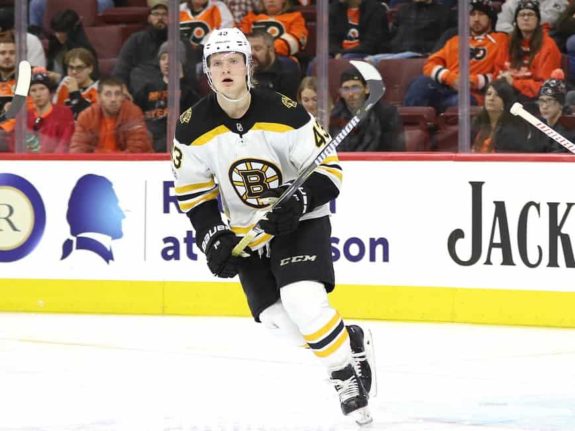
As far as offense goes, it’s easy to look at Heinen’s 11 goals and 34 points in 77 games and be disappointed after he scored 16 goals and 47 points in 77 games as a rookie a season prior. Still, whether it’s depth scoring, strong defensive play or the ability to create an impact along the boards, Heinen has been nothing short of a success at the NHL level. It may not be very obvious because of how quietly he performs, but Heinen is worthy of an extension.
When the dust settles, he’ll likely receive a two or three-year contract worth somewhere between $2 and $2.5 million.
He could continue his role on the team’s third line next season, but he’s also a legitimate candidate to take over a top-six role alongside Patrice Bergeron and Brad Marchand if the team deems him the best internal option to do so, with David Pastrnak slotting onto the second line alongside David Krejci and Jake DeBrusk.
Letting Noel Acciari Walk
It isn’t easy letting someone like Noel Acciari walk given everything he’s given to the team since joining them. A true heart-and-soul player who uses his body like a wrecking ball every time he’s on the ice, he quickly earned a place in the hearts of Bruins fans.
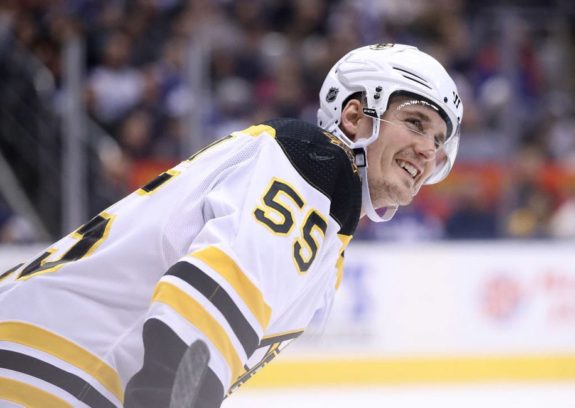
It isn’t the first time a player like Acciari will have walked in recent years either, though, and it should serve as a lesson that the teams can’t fall in love with these fourth line talents to the tune of an annual salary over $1 million per season.
Whether it’s Acciari or Tim Schaller, Gregory Campbell and others before him, there’s always a replacement who can step in and do the job. The team already has Sean Kuraly, Chris Wagner, Karson Kuhlman and Joakim Nordstrom who fit the fourth-line mold and cost. Additionally, David Backes has to be in consideration for a spot on that line if he remains with the team.
Exploring the Trade and Free Agency Markets
The trade and free agency markets are where things can get very serious for the Bruins. The team shouldn’t be looking at any marquee free agents as they simply can’t afford them, but getting a depth contributor or a third-line winger couldn’t hurt.
There will be no shortage of players available, though, and if the Bruins do plan on making a splash, they have their pick of contributors who can step in and help right away.
Some more unlikely names include Artemi Panarin and Matt Duchene who should command the biggest contracts of anybody on the open market. Beyond those players, there remains Joe Pavelski, Kevin Hayes and Anders Lee, all of whom should command significant contracts but who could all fit a top-six need on the Bruins alongside either Krejci or Bergeron.
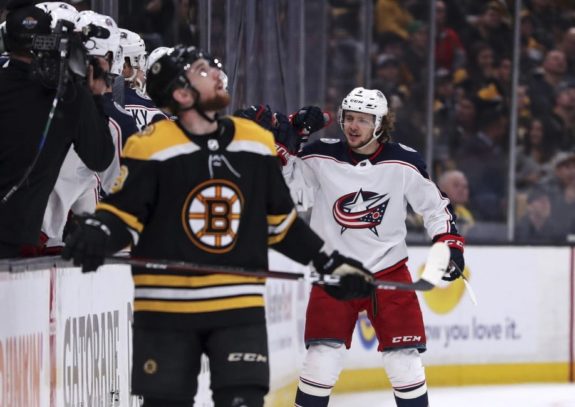
A more realistic option for the Bruins’ third line to replace Johansson, though, would be Ryan Dzingel. It’s possible a team will be interested in over-paying for Dzingel given the fact that he’s recorded 20-plus goals in two consecutive seasons and hit a career-high 26 goals and 46 points in 78 games last season, though. The Bruins could inquire, but the years and dollar value will likely keep them at arms-length.
This is why the trade market is so much more enticing.
Who Could the Bruins Sell High On?
Before we look at trade options the Bruins could acquire, let’s look at who they could be selling.
The Bruins have to figure out the Backes contract situation while also deciding if Torey Krug, John Moore and Kevan Miller fit into their plans.
Moving on from a player like Backes means the Bruins will have to sweeten the pot a little for any acquiring team. Moving Moore or Miller is doable, but Moore’s injuries and return timetable make it hard to figure out any sort of trade for him right now. It’s easier to assume he’s in the plans than the contrary.
This is where the big fish, figuratively speaking, comes into play in Krug.
The Bruins want to compete in the present and moving on from a player like Krug doesn’t make sense in that regard. It makes no sense for a team that was one win away from a Stanley Cup Championship to trade away a player who had a breakout postseason run for the sake of clearing cap space.
In that same vein, though, Krug’s value has never been higher. While it would be foolish to move him simply as a cap casualty, the Bruins would be in a situation where they could look at filling a need in their top-six by moving Krug in a hockey trade.
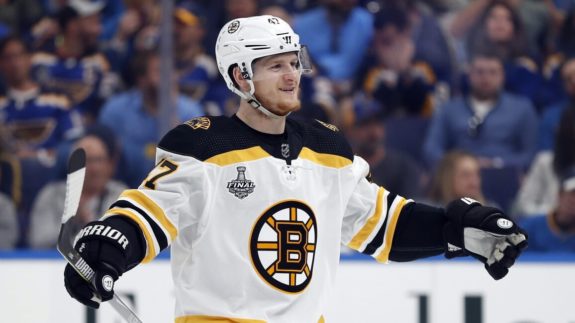
On paper, he can easily fetch a first-round draft pick and a top prospect given the fact that he has one-year remaining on a team-friendly contract. Still, for a team looking for one of the top point-producing defenders in the NHL. While this is an option, the Bruins should instead kill two birds with one stone and turn their attention to addressing a need from a position of strength
The Bruins biggest weakness for the 2018-19 season, a weakness that ultimately cost them the Stanley Cup, was five-on-five scoring. Despite scoring six goals and 53 points in 64 games last season, Krug only scored three goals and 17 points during five-on-five play and four goals and 19 points at even strength.
This isn’t to say Krug isn’t one of the best offensive talents in the NHL at his position, but it is clear that his production at five-on-five doesn’t merit a contract worth upwards of $7 million per season on a team filled to the brim with left-shot defenders and cap space troubles looming already.
With that said, who should the Bruins be targeting in trades this offseason?
Who Should the Bruins Try to Acquire?
To preface this, it should be made clear that the players mentioned in this section don’t necessarily have to be dealt in a trade involving Krug. While Krug should be discussed in trade talks, the team also has a plethora of prospects and draft picks that can still be used to entice a team in trade discussion.
The first and most obvious name on this list is Jesse Puljujarvi.
A low-risk, high-reward option in its truest form, the Bruins should be all-in on acquiring Puljujarvi from the Edmonton Oilers. This is especially true given the looming cap issues that are creeping up again in Boston.
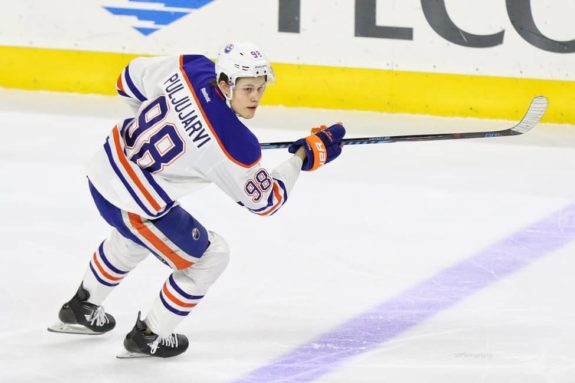
The fourth-overall pick from the 2016 NHL Entry Draft, Puljujarvi was considered to be on the same level as Auston Matthews and Patrik Laine pre-draft. The fact that he went fourth overall was a shock in itself and many questioned why the Columbus Blue Jackets would let him slip through their fingers at third overall.
The Oilers saw the value in Puljujarvi, though, and it’s hard to fault them for that. A 6-foot-4, 223-pound right-winger with the ability to play a true power-forward role as a playermaker and a shooter, Puljujarvi is excellent at generating shots and playing the game at high-speeds.
If the Oilers are looking to collect any value they can for him, the Bruins could come into the fold with a player like Jakub Zboril and a mid-to-high round draft pick to fill a need while dealing from the aforementioned position of strength.
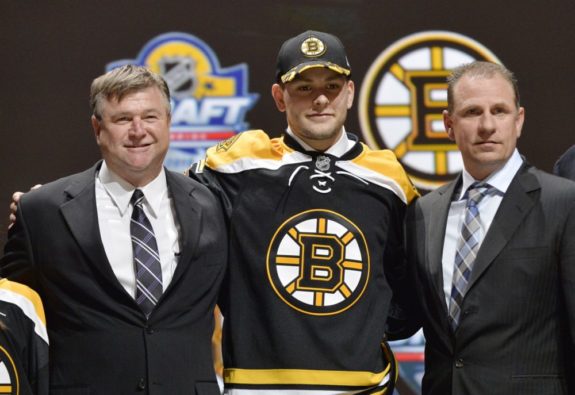
While Zboril has taken strides, he’s behind both Jeremy Lauzon and Urho Vaakanainen in the current pecking order and the Bruins should capitalize now on getting value back for him.
Keeping in the theme of acquiring a power forward, the Bruins could also turn their heads towards Chris Kreider
Kreider and the Bruins Have Long Been Linked
If the Bruins want to go all-in and aren’t worried about the salary cap ramifications or the long-term impact it could have, Kreider is a good-but-not-perfect option.
While Kreider makes sense given his combination of size, speed and skill as well as the fact he’s from Boxford, Massachusetts, he wouldn’t come cheaply for the Bruins.
The Rangers are a team looking to contend sooner than later and taking on bad contracts at this stage in their timeline doesn’t seem likely. For that reason, the Bruins wouldn’t be looking at dumping a bad salary to New York to balance cap space while overpaying in terms of prospects and draft picks to bring him to the team. Instead, the’d almost certainly have to include a good player making substantial money to help balance the money.
This is where a Krug trade could come into play as both players are on expiring deals and could fill a need for the receiving team.
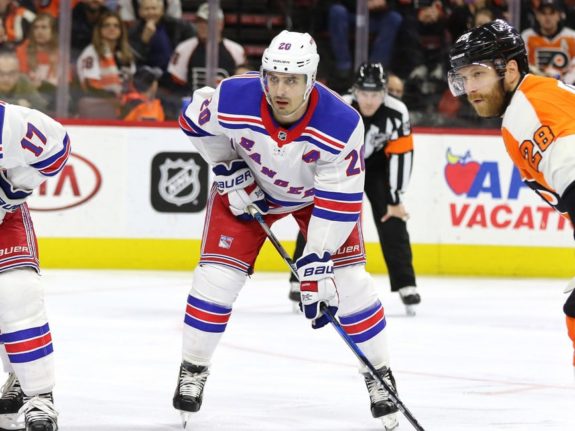
The reason Kreider was originally described as a good-but-not-perfect option, though, is because he’s a left-winger.
His 28 goals and 52 points form a season ago are certainly enticing, especially considering he’s a near lock for 20-plus goals and 40-plus points each season. This is only amplified by the fact that he’s set to earn a team-friendly $4.625 million next season.
At the same time, though, the Bruins need a right-shot right-winger who can come in and finally fill a need next to Krejci that hasn’t been filled in years.
Moving DeBrusk to the right-side didn’t yield positive results for the Bruins and hampering his production and development to best accommodate Kreider just doesn’t make much sense on paper.
With that said, Kreider is exactly the kind of player the Bruins need right now.
If the Bruins don’t necessarily care about the left-shot and right-shot debate, though, they could look at a left-shot player who’s comfortable skating on both wings.
Jason Zucker Fits the Bill
Another player the Bruins have been reportedly looking into is Jason Zucker from the Minnesota Wild.
A 27-year-old winger set to earn $5.5 million in each of the next four seasons, Zucker is a proven player who can absolutely score goals and make plays at even-strength and on the power play.
Zucker would score 21 goals and 42 points last season. He scored 14 goals and 28 points in 2018-19 and was a big contributor on the Wild’s power play as well, scoring another seven goals and 14 points up a player.
This was after an impressive 2017-18 season that saw him set career-highs in goals (33), assists (31), points (64) and games played (82). Even more impressive is the fact that 25 goals and 20 assists from that career-high-setting season came at even strength.
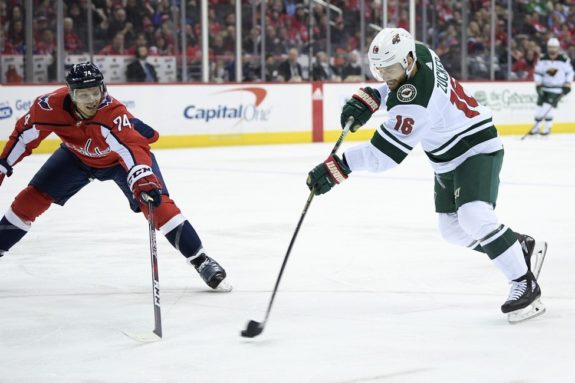
A player like Zucker won’t come cheap, but the Bruins do have some recent history with the Wild after they sent Ryan Donato to the team in the trade that saw Coyle brought to Boston.
While Zucker and Coyle wouldn’t be playing alongside each other in Boston, that familiarity would be a nice touch at the very least.
The Wild are a team in transition right now and acquiring someone like Krug wouldn’t be the worst thing for a team that’s already set as far as top-four defenders go in Ryan Suter, Matt Dumba, Jared Spurgeon and Jonas Brodin. Krug would step in and be the perfect fifth option on the team while taking on a significant power play role.
If the Wild are looking at another young player with NHL potential who hasn’t had a fair shake on the NHL level similar to that of Donato, Peter Cehlarik is another interesting name who could be used in a bigger package to acquire Zucker or someone else entirely.
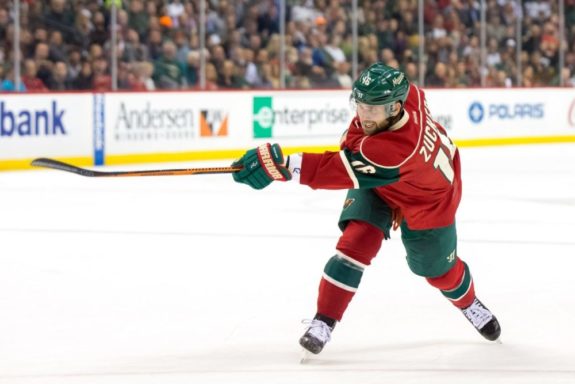
While Cehlarik is an interesting name to include here, he shouldn’t be confused as the main piece of any trade discussions. With just five goals and 10 points in 37 NHL games to date and significantly less than a point-per-game pace at the AHL level, Cehlarik is a mid-level prospect more than he is a top-tier trade piece at this point in his career.
There are certainly other names to kick tires on than just the three mentioned, but those are the three big fish that have already been linked to the Bruins in some way, shape or form this offseason.
Closing Thoughts on the Bruins Offseason Outlook
The Bruins are a team looking to compete in the present while maintaining a strong presence in the future. It’s for that reason that every single move they make has to be done with an eye towards the future while looking at adding to the current contending roster.
It’s a fine line to balance.
In the end, Sweeney is almost certainly going to make moves this offseason that will make many people happy, many people unhappy, some feeling underwhelmed and some feeling overwhelmed.
There’s no right answer to the puzzle as far as professional sports are concerned and anything can change in an instant.
With that, the Bruins 2019 offseason is underway and it should be a busy one.